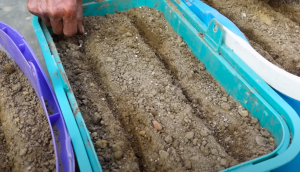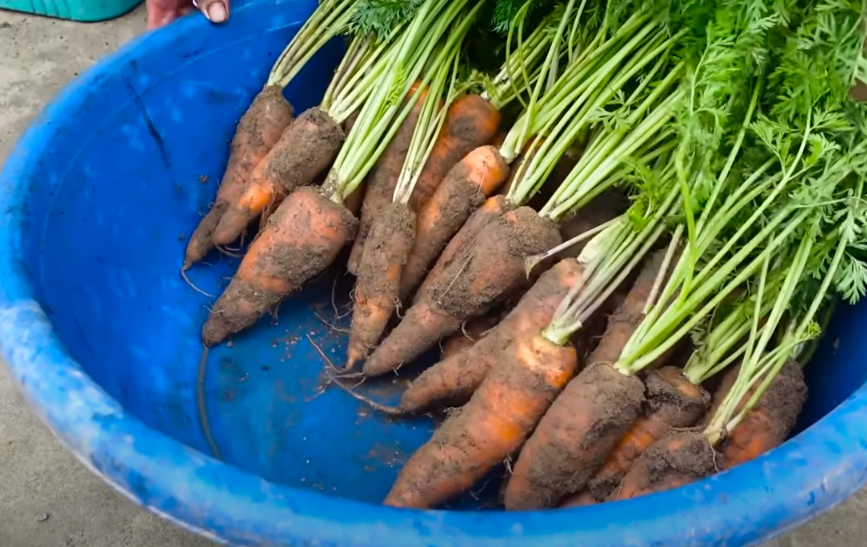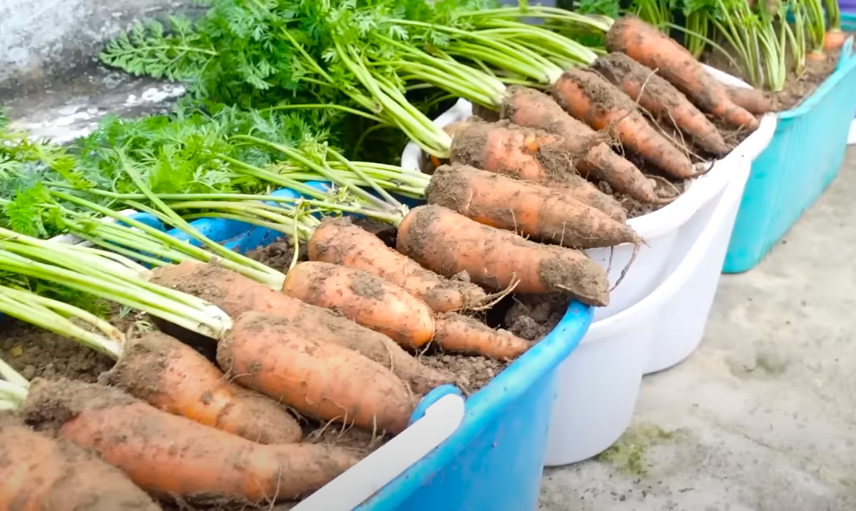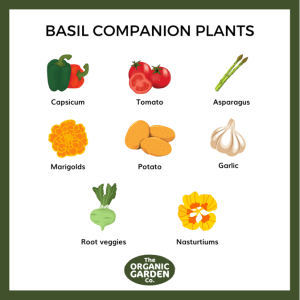The first steps in growing carrots at home are selecting a sunny location and getting loose, well-draining soil ready. Directly sow seeds into the earth, giving them a 2-inch gap between each one.
Growing your own carrots can be a rewarding experience, offering the promise of fresh, crisp vegetables right from your backyard or balcony.
Carrots, known for their nutritional value and versatility in cooking, are a cool-weather crop ideal for many home gardeners.
Getting started requires minimal equipment and a little know-how. This guide will help you understand the key steps to successful carrot cultivation, from soil preparation to harvesting. By following simple gardening techniques,
you can enjoy a bountiful harvest of this root vegetable. Whether you have a large garden or just a small outdoor space, planting carrots can be a fun and fruitful endeavor.
Choosing The Right Carrot Variety
Embarking on the carrot-growing journey starts with selecting the perfect variety. Carrots come in many shapes, sizes, and colors, each with unique tastes and growth requirements.
Finding the right type for your garden is crucial to a bountiful harvest. Let’s dig into factors to consider when picking the ideal carrot for your home garden.
Consider Your Climate
Your local climate plays a significant role in determining the carrot variety that will thrive in your garden. Carrots prefer cooler temperatures, making them excellent for spring and fall planting.
Shorter growing varieties often suit warmer climates, while longer, heavier carrots prosper in cooler areas.
- Warm climates: Choose varieties that can tolerate heat, such as ‘Nantes’ or ‘Oxheart’.
- Cooler climates: Opt for ‘Imperator’ or ‘Danvers’, which excel in colder weather.
Exploring Heirloom And Hybrid Types
Diving into the world of carrots, you’ll find heirloom and hybrid options. Heirlooms, passed down through generations, offer traditional flavors and organic seeds. Hybrids, created for specific traits, often promise improved growth and disease resistance.
| Type | Benefits | Example Varieties |
|---|---|---|
| Heirloom | Rich flavors, sustainable seeds | ‘Scarlet Nantes’, ‘Chante nay Red Core’ |
| Hybrid | Better yield, resistance to pests | ‘Sugars ax 54’, ‘Hokum’ |
Whether you lean towards the charm of heirlooms or the vigor of hybrids, your choice will influence your gardening experience and the taste of your harvest. Make sure to consider both types before planting.

Preparation Of Soil And Bed
Ready to turn your garden into a carrot wonderland? Great soil and a well-prepared bed are the secret ingredients! Let’s dig into the key steps for creating a perfect home for your carrots to thrive.
Creating The Ideal Soil Mix
Carrots love loose, rich, and well-draining soil. Here’s how to make it:
- Start with a base of garden soil.
- Mix in compost to add nutrients.
- Add sand for better drainage.
- Peat moss or coconut coir can help retain moisture.
Balance the mix until it’s fluffy and clump-free. Your carrots will need this to grow straight and strong!
Bed Shape And Depth For Root Growth
Your carrot bed is like a cozy house for your seeds. Getting the shape and depth right is vital for deep roots.
| Bed Shape | Depth |
|---|---|
| Raised beds or flat areas | At least 12 inches deep |
Ensure the bed is free of rocks and debris. This gives carrots the unobstructed space they require to grow long and tasty.
Sowing Carrot Seeds Effectively
Germinating carrot seeds calls for attention to detail. Supervise the process to ensure a bumper harvest. Prepare to learn top sowing methods for excellent carrots.
Optimal Spacing Techniques
Spacing affects carrot growth. Too close, they compete; too far, space is wasted.
- Row spacing: Allow 6-8 inches between rows.
- Seed spacing: Place seeds 2-3 inches apart in the row.
- Thinning: After germination, thin seedlings to 1-2 inches.
Correct spacing ensures ample nutrients, sunlight, and airflow for each carrot.
Depth And Moisture Conditions
Carrot seeds thrive in moist, well-drained soil. An inch of water per week suffices.
| Depth for Planting | Watering Frequency |
|---|---|
| 1/4 inch deep in soil | Keep soil consistently damp |
Use a fine mist to water seeds without washing them away. A light layer of peat moss retains moisture.
Caring For Carrot Plants
Caring for carrot plants requires attention to detail and a bit of gardening know-how. Once the carrot seeds have germinated, and tiny green shoots punctuate the soil, it’s time to focus on the nurturing phase.
Proper care ensures your carrots grow healthy, flavorful, and crunchy. Let’s explore the strategies that will help your carrots flourish in your home garden.
Watering Strategies
Consistent moisture is key for carrot growth. Keep the soil evenly moist but avoid overwatering. Follow these simple tips:
- Water deeply once or twice a week.
- Avoid shallow watering; it encourages poor root development.
- Use a mulch layer to retain soil moisture.
- Check soil moisture levels regularly; they should feel moist but not soggy.
Thinning Seedlings
To prevent overcrowding, thinning is necessary. Overcrowded plants won’t have room to grow. Here’s how to thin your carrot seedlings:
- Wait until seedlings are about an inch tall.
- Remove the smallest plants, leaving stronger seedlings space to develop.
- Ensure remaining plants are about 2-3 inches apart.
- After thinning, water your carrots gently to settle the soil.
Combatting Pests And Diseases
Carrots can face issues like pests and diseases. Stay vigilant and act promptly:
| Pest/Disease | Signs | Action |
|---|---|---|
| Carrot Fly | Foliage discoloring | Use fine mesh to cover plants. |
| Root Knot Nematodes | Galls on roots | Rotate crops yearly. |
| Fungal Diseases | Mold on leaves | Improve air circulation and reduce humidity around plants. |
Regular inspections can prevent small issues from becoming big problems. Remove any affected foliage or plants to stop the spread of disease.
Harvesting And Storing Your Carrots

Growing carrots at home is a rewarding process. Now comes the best part – enjoying the fruits of your labor. Harvesting and storing are critical to maintain the crunch and sweetness of your homegrown carrots. Do it right, and you’ll have a delightful stock of this root vegetable to enjoy.
Recognizing Harvest Time
Carrots are ready to harvest when they show a bit of their crown above the soil. The color also indicates ripeness. Look for a deep, vibrant hue for the best taste.
- Check the size: Small and medium carrots are often sweeter.
- Feel the tops: If they’re firm, it’s time to pick.
Gentle Uprooting Methods
Be gentle when removing carrots from the soil to prevent damage. Use these steps:
- Water the soil around the carrots. This makes pulling easier.
- Grasp the top close to the root.
- Wiggle the carrot while pulling up slowly.
If resistance is felt, use a garden fork to loosen the soil. Avoid pulling too hard to prevent snapping.
Long-term Storage Tips
For storing carrots, cool and moist conditions work best. Here’s how to keep them fresh:
| Method | Steps |
|---|---|
| Refrigeration |
|
| Root Cellaring |
|
Check your carrots regularly. Remove any that show signs of rot to protect the rest.
Frequently Asked Questions
When Is The Best Time To Plant Carrots?
Carrot seeds thrive when planted in cooler temperatures. The ideal time for sowing is in early spring, a few weeks before the last frost date. You can also opt for a late summer planting for a fall harvest.
What Soil Is Best For Growing Carrots?
Carrots prefer loose, well-drained soil rich in organic matter. Sandy or loamy soils allow for better root development. Avoid heavy, compacted, or rocky soil, as it may lead to deformed carrots. A pH between 6. 0 and 6. 8 is optimal.
How Deep Should I Plant Carrot Seeds?
Carrot seeds should be sown shallowly, about 1/4 inch deep. This ensures that the fragile seedlings can break through the soil surface. Proper spacing is crucial; aim for 2-3 inches apart to avoid overcrowding and promote even growth.
How Much Water Do Carrots Need?
Carrots need consistent moisture, especially during seed germination and root formation. Aim to water at least 1 inch per week. Avoid overwatering, as it can lead to root rot. Use mulch to retain soil moisture and prevent weeds.
Conclusion
Growing carrots at home can be a delightful and rewarding experience. With the right soil, adequate sunlight, and proper care, your garden will provide a bountiful carrot harvest. Embrace the process, from sowing to harvesting, and enjoy the fresh, crisp taste of homegrown carrots right from your backyard—satisfaction with every crunch!






One Response